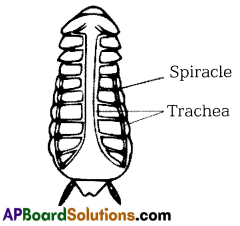These TS 7th Class Science Important Questions 11th Lesson Respiration in Organisms will help the students to improve their time and approach.
TS 7th Class Science Important Questions 11th Lesson Respiration in Organisms
Question 1.
Choose the correct answer and give reasons :
i. The process which involves the exchange of gases is called ( )
A. Respiration
B. Circulation
C. Digestion
D. Breathing
Answer:
D. Breathing
Reason: Breathing in and breathing out air influences exchange of gases.
![]()
ii. During inspiration air enters into lungs due to ( )
A. increased volume of thoracic cavity
B. fall in pressure inside the lungs
C. increase in the volume of thoracic cavity and fall in lung pressure.
D. Muscular expansion of lungs.
Answer:
C. increase in the volume of thoracic cavity and fall in lung pressure.
Reason: During inhalation the chest or thoracic cavity expands by its volume as a result the pressure decreases in the lungs.
iii. Roots respire through ( )
A. spiracles
B. lenticels
C. stomata
D. air spaces
Answer:
B. lenticels
Reason: Lenticels are the specialised cells appear on the stem bark and root coat.
Eg: Mangroove plant roots.
iv. Which of the following animals breathe through their skin and lungs?
A. Fish
B. Frog
C. Snake
D. Earthworm
Answer:
B. Frog
Reason : When frog is in water it respires through skin and obtains dissolved oxygen. When it is on land it respires through lungs.
![]()
v. What happens to lime water, when we exhale air into it? ( )
A. Remains same
B. Turns blue
C. Turns milky
D. Become colourless
Answer:
C. Turns milky
Reason : The carbon dioxide present in the exhaled air reacts with lime water and converts lime water into milky white.
vi. Plants respire through ( )
A. cells
B. stomata
C. gills
D. cell membrane
Answer:
B. stomata
Reason: Plants perform respiration through stomata present in leaves.
vii. The respiratory organs in cockroach are ( )
A. lungs
B. gills
C. lenticels
D. spiracles
Answer:
D. spiracles
Reason: Spiracles are the external openings located on the side of the body that act as respiratory organs.
Question 2.
Write about discovery of oxygen.
Answer:
- Joseph Priestly was the first person who gave evidence for the presence of oxygen.
- He proved the qualities of gases released by plants and the ones exhaled by animals.
- He observed candle burning continuously in a closed container after adding a living stem of mint to the container.
- At that time he did not know that it was oxygen.
- But he concluded that the mint stem “restored’1 the air that the burning candle had spoiled.
- Lavoiser took the necessary observations from Priestly. He had also conducted several experiments on atmospheric air that contained mixture of gases.
- At last Lavoiser identified Priestley’s discovery as the active component of air for which he had been searching. He called it oxygen.
Question 3.
Do you know how cockroaches respire? Explain briefly that you learnt from your teacher.
Answer:
- Cockroach is an insect. It doesn’t have coloured blood.
- It has special respiratory organs for respiration called air tubes or trachea or respiratory tubes.
- On the underside of the cockroach in each segment, there are small holes which are connected through respiratory tubes in a network.
- These help the cockroach to breathe. These are called spiracles.
- The network of respiratory tubes (trachea) take air from these spiracles, circulate it throughout the body, collect it back and send it out through these spiracles.
![]()
Question 4.
How do earthworms respire?
Answer:
Earthworms breathe through their skin. The skin is thin and moist with minute holes.
Through the skin, air passes in and out.
The earthworm thus breathes through its whole body surface.
Question 5.
What question would you pose to clarify the doubts on respiration in plants?
Answer:
- How is respiration carried out in plants?
- What are the parts of plant involved in respiration?
- Is there any comparison between respiration in plants and animals?
- What happens if respiration is absent in plants?
Question 6.
What would happen if oxygen decreases in the atmosphere?
Answer:
1. Oxygen is an important gas for all the living organisms.
2. If oxygen level decreases in the atmosphere the following problems will arise.
- All the organisms will struggle in breathing.
- Organisms cannot obtain energy in their body.
- Carbon dioxide content will decrease in the atmosphere as animals unable to release it.
- Then plants will struggle in preparing food.
- Finally all the organisms will face problems and may die.
Question 7.
How can you show our chest expands with breathing? Narrate a simple experiment by doing in the class room.
Answer:
I can show with the following simple experiment that our chest expands on breathing. I took a length of twine or a measuring tape. I called one of my friends for measuring his expanded chest on respiration. The tape is wrapped around his chest. The width of his chest is measured. The tape is held around the chest lightly and asked him to breathe in and out deeply a few seconds.
Observation: It is observed thìt the length of the tape rises on breathing when compared to the chest in resting stage.
![]()
Question 8.
Can you measure the inhaled air that you take in one maximum breathing?
Discuss with your friends. Do the experiment with available low cost material. Write the result.
Answer:
Aim : To measure the inhaled air that I take in one maximum breathing.
Apparatus : A two litre water bottle, syringe, rubber tube, small tub, water.
Procedure :
Step 1 : In the first stage a measuring cylinder is made by the following way.
A 2-litre empty water bottle is taken. With the help of syringe 100 ml of water is poured into bottle. The level of water is marked on the bottle at each step. Like that the bottle is filled with water by pouring step by step with the syringe. It is filled upto the brim.
Step 2 : The bottle is inverted in a water tub or bucket. We should see that no air bubble is present inside the bottle. One end of the rubber tube is inverted into the mouth of the bottle under water. The other end of the tube is kept in my mouth. I inhaled as much as air I can blow in a single breathe into the measuring cylinder through tube.
Observation : The air entered cylinder and pushed down the water upto certain level. As a result the water level in the cylinder will fall. The reduction in water level is equal to the air I breathe.

Question 9.
In the given picture there is a lime water in A and B test tubes. A boy is breathing out the air into the test tubes. Predict your answers for the following.

1. What was the colour of lime water in test tubes ‘A’ and ‘B’ before you began the experiment?
2. In which test tube did the lime water turn milky after you blew in and sucked out air?
3. What difference between inspired and expired air?
Answer:
1. Colour of lime water before blowing air is colourless and the water is undisturbed.
2. In the test tube ‘B’ the lime water turns more milky white after blowing air to the test tube ‘A’. It means less milky colour is seen in test tube ‘A’. Because the inhaling tube is merged in the water and the releasing air directly contacts with lime water.
3. Inhaled air contains all the mixture of gases, but expired air contains less amount of oxygen and more amount of carbon dioxide and unchanged percentage of other gases which enter during in inspiration.
![]()
Question 10.
What materials are used to conduct experiment on respiration with the help of sprouted seeds?
Answer:
Two holed rubber cork, glass tubes, conical flask, germinated seeds, funnel, lime water, water etc.
Question 11.
Read the table and answer the questions.
|
S.No |
Animal name | Respiratory organs |
|
1. |
Frog |
Lungs or skin |
|
2. |
Fish | Gills |
| 3. | Grasshopper |
Spiracles |
| 4. | Man |
Lungs |
i. What are the respiratory organs of man?
ii. How does a frog respire when it enters the water body?
iii. In which organism we find spiracles as respiratory organs?
iv. Tadpole larva of frog respires through ?
Answer:
i. Lungs
ii. Frog respires through skin in the water
iii. Grasshopper has spiracles for respiration
iv. Gills.
Question 12.
Name the given picture. How does it respire?

Answer:
The given diagram shows gills in tadpole of frog.
In baby frogs or tadpoles there are special organs like fish gills.
These gills help them to breathe in water by taking dissolved oxygen.
![]()
Question 13.
Draw the diagram of grasshopper showing the respiratory parts. Give a comment on it.

Answer:
Grasshopper has small openings on the sides of its body. On the underside in each segment there are small holes which are connected through respiratory tubes in a network. These are called spiracles. These help the grasshopper to breathe.
Question 14.
How man takes advantages through artificially extracted oxygen?
(or)
How oxygen is considered commercially great supporter in our day to day life?
Answer:
- Hospitals preserve oxygen cylinders for the patients in critical conditions.
- Sometimes a patient is given oxygen during operations.
- Mountaineers carry oxygen cylinders when they go up to the high altitudes.
Question 15.
What had Von Helmont and Joseph Black contributed to the living world with their achievements?
Answer:
- Von Helmont and Joseph Black had discovered the presence of carbon dioxide in the atmosphere.
- Von Helmont conducted an experiment of burning of charcoal which leads to the formation of ash.
- He found the weight of ash is less compared to charcoal. He concluded that there was a gas that influenced decrease in mass of the charcoal.
- Joseph Black studied Helmont’s experiment in more detail. He found that gas is released on heating limestone or reacted with acids. That released gas is called “fixed air”.
- Later Black studied several properties of this gas.
- One such a property is the milky white appearance of lime water by passing the collected gas. Now we know this gas is carbon dioxide.
- Both Helmont and Black demonstrated the presence of carbon dioxide in the atmosphere clearly.
Choose the correct answer:
I. Conceptual Understanding
Question 1.
This is released out along with carbon dioxide during respiration.
A) water
B) water vapour
C) volatile gases
D) dust
Answer:
B) water vapour
![]()
Question 2.
Find out the respiratory organ. ( )
A) Larynx
B) sound box
C) heart
D) trachea
Answer:
D) trachea
Question 3.
These help in exchange of gases in plants. ( )
A) Stomata
B) Lenticels
C) gills
D) A & B
Answer:
D) A & B
Question 4.
The respiratory part in Earthworm. ( )
A) skin
B) lungs
C) Trachea
D) Gills
Answer:
A) skin
Question 5.
When frog is in burrows it respires with ….. ( )
A) lungs
B) gills
C) skin
D) trachea
Answer:
C) skin
Question 6.
Lenticels are present on the surface of …………….. ( )
A) leaves
B) stem
C) bud
D) seed
Answer:
B) stem
![]()
Question 7.
The tadpole larva of frog respires through …. ( )
A) gills
B) lungs
C) kidneys
D) heart
Answer:
A) gills
II. Asking Questions and Making Hypothesis
Question 8.
What would happen if fish is kept outside of the water? ( )
A) It canot breathe
B) It will struggle to survive
C) It runs very fast
D) A & B options.
Answer:
D) A & B options.
Question 9.
Frame a relevant question on respiration in different organisms with different organs. ( )
A) What are the parts of respiratory organs in organisms ?
B) What is the reason behind development of different respiratory organs in different animals?
C) Where do we find respiratory organs in all the organisms?
D) Why do organisms have many respiratory organs for respiration?
Answer:
B) What is the reason behind development of different respiratory organs in different animals?
Question 10.
It is trachea for cockroach. Then what is for birds? ( )
A) gills
B) skin
C) lungs
D) trachea
Answer:
C) lungs
III. Experimentation and Field lnvestigation
Question 11.
These are used to test the released carbondioxide from the plants.
A) Flowers
B) Buds
C) Sprouted seeds
D) Above all
Answer:
D) Above all
![]()
Question 12.
What changes are observed in the lime water with which flowers or buds contacted. ( )
A) lime water turns milky
B) lime water becomes unchanged
C) lime water turns residue
D) lime water turns yellow
Answer:
A) lime water turns milky
Question 13.
These are mostly used for testing the gases in the laboratory. ( )
A) Methyl orange
B) Hydrochloric acid
C) Phenolpthalene
D) Acetic acid
Answer:
C) Phenolpthalene
Question 14.
i. What colour is seen in the boiling tube with lime water after blowing the air into it?
ii. What would be the reason for that? ( )
A) i. milky white ii. oxygen
B) i. milky white ii. carbon dioxide
C) i. no colour change ii. carbon dioxide
D) i. no colour change ii. oxygen
Answer:
B) i. milky white ii. carbon dioxide
IV. Information Skills and Projects
Question 15.
Read the given table and answer the question.

Q. How much of oxygen is exhaled out in breathing?
A) 210 ml
B) 40 ml
C) 165 ml
D) 201 ml
Answer:
C) 165 ml
Question 16.
Read the paragraph and answer the question:
Earthworms breathe through their skin. It is thin and moist with minute holes. Through the skin air passes in and out. ( )
Q. What is essential for earthworm to breathe oxygen through skin continuously?
A) skin is always in moist state
B) skin has tiny holes
C) lungs are essential
D) A & B
Answer:
D) A & B
![]()
Question 17.
The cylinders used in hospitals for patients are filled with which gas? ( )
A) Carbon dioxide
B) Oxygen
C) Nitrogen
D) Other gases
Answer:
B) Oxygen
Question 18.
The above given diagram reveals ………………..

A) Measuring the gases in one breathe
B) Measuring the water in one breathe
C) Observing the changes in the cylinder
D) Observing the changes in the gases
Answer:
A) Measuring the gases in one breathe
V. Communication through Drawing and Model Making
Question 19.
Name the part marked with ‘?’ that are developed in tadpole larva of frog? ( )

A) Bristle of head
B) Branched trachea
C) Gills
D) hairs of head
Answer:
C) Gills
![]()
VII. Appreciation And Aesthetic Sense And Values And Application To Daily Life And Concern To Bio Diversity
Question 20.
These will affect the rate of respiration.
A) Excercise
B) Running
C) Doing work very fast
D) All the above
Answer:
D) All the above